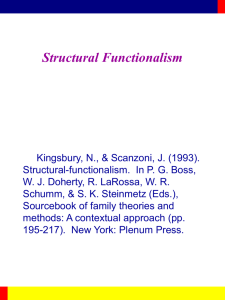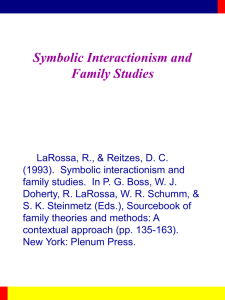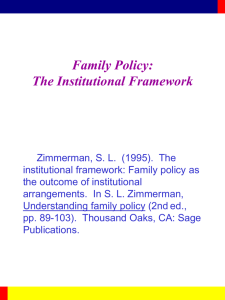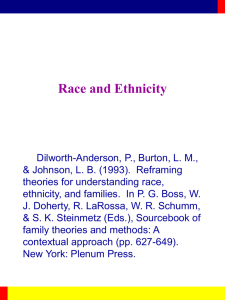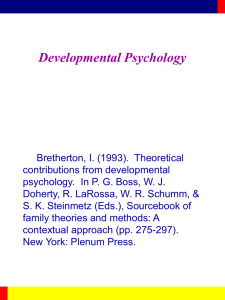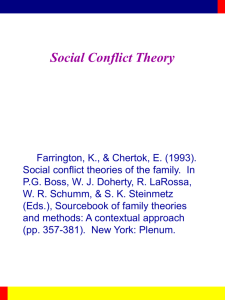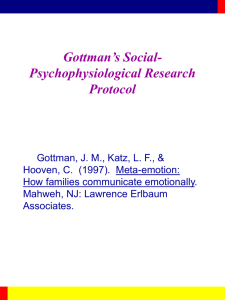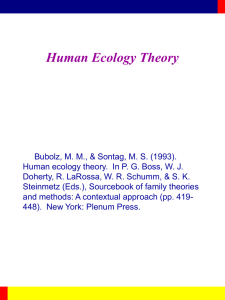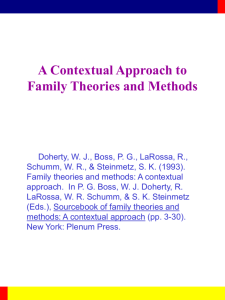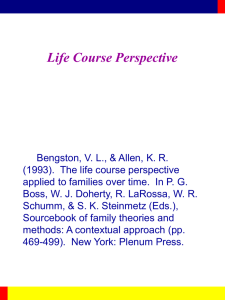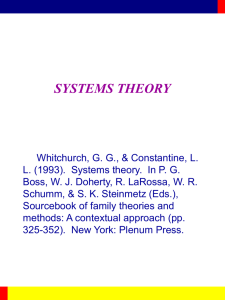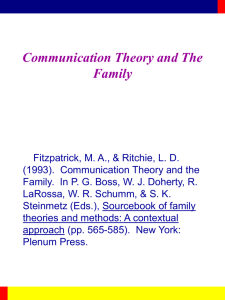Family Therapy Theory
advertisement
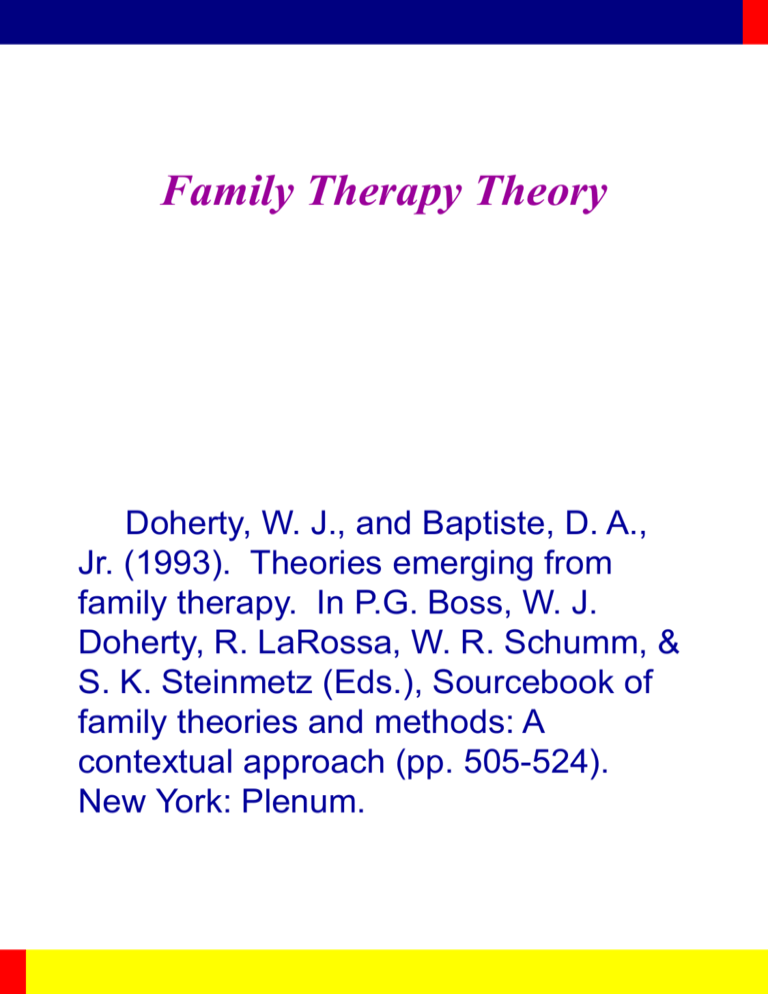
Family Therapy Theory Doherty, W. J., and Baptiste, D. A., Jr. (1993). Theories emerging from family therapy. In P.G. Boss, W. J. Doherty, R. LaRossa, W. R. Schumm, & S. K. Steinmetz (Eds.), Sourcebook of family theories and methods: A contextual approach (pp. 505-524). New York: Plenum. Historical Development Gregory Bateson suggested two forms of communication: Verbal (a/k/a digital): what is said. Nonverbal (a/k/a analogic): provides the context for the digital, providing interpretative information. This is referred to as a metamessage. The Palo Alto Team: Double bind hypothesis: a sequence of interaction which featured a contradiction between the contextual and verbal levels. Family homeostasis, influenced by cybernetics: families were calibrated like a furnace to maintain themselves within tolerable limits. Dr. Ronald J. Werner-Wilson Historical Development (cont.) Murray Bowen Use a biological metaphor which linked individual and family differentiation. Family process influenced an individual differentiation of self, a balance between intellectual and emotional functioning. autonomy and togetherness in social relationships. Families transmit level of differentiation. Salvador Minuchin: Structural Family Therapy Families have functions which: socialization of children mutual support or married couples. Families are systems which operate through subsystems which require adequate boundary clarity and permeability. Family problems are the result of boundaries which are too porous (enmeshed) boundaries which are too rigid (disengaged). Dr. Ronald J. Werner-Wilson Historical Development (cont.) Recent Developments Milan approach Constructivism: infusion of epistemology (theories of knowing) and other ideas. Reality cannot be assessed objectively because it is a subjective experience. Reflexivity: the observer is part of the system being observed. Dr. Ronald J. Werner-Wilson Working Assumptions of Family Therapy Theories Family relationships are a principal source of mental health and psychopathology for individuals. Family interaction patterns tend to repeat across generations. Family health requires a balance of connection and individuation. Family flexibility is a core trait that prevents family dysfunction. The triad is the minimum unit for a complex understanding of family interactions. Individuals' symptoms frequently have meaning within the family's interaction patterns or worldview. Dr. Ronald J. Werner-Wilson Major Questions Addressed by Family Therapy Theories How do individuals develop psychosocial symptoms within families? How do families maintain levels of interpersonal connection that allow for emotional bonding and individual autonomy? How does family conflict become unmanageable? How can families change dysfunctional patterns? Dr. Ronald J. Werner-Wilson Major Contemporary Concepts Boundaries: family rules which determine membership in systems and responsibilities. Triangles: triadic interactional configurations which is the basic building block of any emotional system. When a two-party system becomes unstable because of anxiety, a third person is involved to stabilize them. Coalitions: negative alliances between two or more family members, a version of triangles. Family belief systems: problems are maintained by the families construction of the problem. Self Processes: The field is divided into two groups One group emphasizes only family processes. A second group is influenced by one of two theoretical orientations Object relations concepts (e.g., Framo, Scharff & Scharff). Self-differentiation (Bowen). Dr. Ronald J. Werner-Wilson Family Therapy Theory and Research on Psychosomatic Families Theory: enmeshed, overprotective, rigid, and inadequate conflict resolution transactional patterns are associated with the following medial problems: anorexia nervosa poor control of diabetes asthma Results: general support for hypothesis. Children from psychosomatic families had higher levels of FFA than control group when they observed parental conflict. Parents in psychosomatic families relaxed when children entered the room; the child’s FFA level increased. Dr. Ronald J. Werner-Wilson Family Therapy Theory and Research on Schizophrenia Major contributions to the understanding of schizophrenia only occurred after researchers accepted the notion that it is a biologically based disease. Researchers began to study the influence of family factors intensify problems and lead to relapse. Expressed Emotion (EE): Refers to the level of criticalness and emotional overinvolvement of a family member to another family member with a psychiatric impairment. Measured during a Camberwell Family Interview, a 90-minute semi-structured interview. People from high EE families are likely to relapse three to four times more rapidly. Expressed emotion has also been used to predict relapse in depression, manic-depressive disorder, obesity. Dr. Ronald J. Werner-Wilson Limitations of Family Therapy Theory Two Standard Criticisms: Individual psychological factors were neglected. Lack of clear operationalization of the constructs for research purposes. Three New Critiques: Feminist Critique Race/Ethnic Diversity Systems in Context: Need to Examine Larger Social Systems Dr. Ronald J. Werner-Wilson Limitations of Family Therapy Theory (cont.) Feminist Critique: Doherty and Baptiste (1993) suggest that feminism has entered the mainstream of theoretical work in family therapy. Main points of the feminist critique: Traditional theory ignored gender. Traditional theory ignored sociocultural and political contexts of family life. Traditional theory reinforced traditional roles. Traditional theory ignored issues of power and differential vulnerability of men and women to exploitation (Doherty & Baptiste, 1993, p. 518). Dr. Ronald J. Werner-Wilson Limitations of Family Therapy Theory (cont.) Critique Based on Race/Ethnicity. Two problems: Theoretical myth of sameness. Use of stereotypes. Critique Based on Larger Social Systems: Families are influenced by their interactions with major environmental systems (e.g., health care system, schools, legal system, mental health and social service systems). Emerging consensus, as a result of collaboration with medical professionals: adequate family theory must involve a biopsychosocial perspective (e.g., mind, body, and larger social systems). Dr. Ronald J. Werner-Wilson Future Directions Emergent Trends Greater link between theory and assessment. Greater emphasis on biopsychosocial models. Emphasis on constructivist approaches to family theory. Analysis of the family as a group that observes itself and its environment formulates hypotheses, and holds lasting belief patterns (Doherty & Baptiste, 1993, p. 521). Emphasize race/ethnicity and gender. Two Divergent Paths Theory that is tied directly to research activities. Theory that is influenced by nontraditional research paradigms which emphasize epistemology (theory of knowing) and properties of interacting therapeutic systems. Dr. Ronald J. Werner-Wilson
